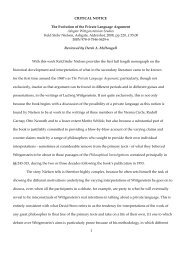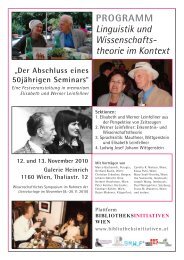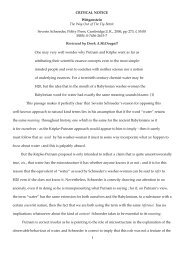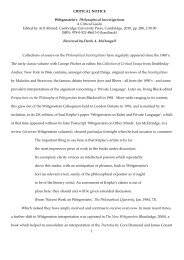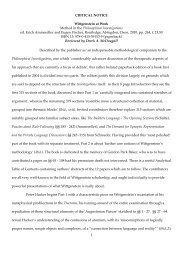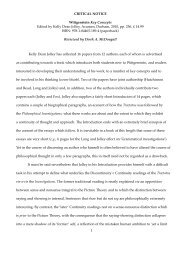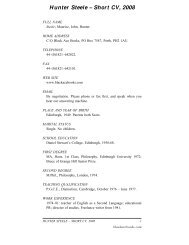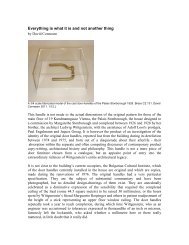CRITICAL NOTICE The Enchantment of Words Wittgenstein's ...
CRITICAL NOTICE The Enchantment of Words Wittgenstein's ...
CRITICAL NOTICE The Enchantment of Words Wittgenstein's ...
Create successful ePaper yourself
Turn your PDF publications into a flip-book with our unique Google optimized e-Paper software.
participants in this kind <strong>of</strong> complex moving scena, can more accurately explain what really occurred.<br />
Another important feature <strong>of</strong> this story, and one which directly relates it to the ‘picture<br />
analogy’ referred to by Denis McManus in the fifth Chapter <strong>of</strong> his book, is that the items used to<br />
represent the various participants in the battle, in order to fulfil their roles, do not have in any way<br />
to resemble the actual individuals who took part in it. Yet as McManus reminds us, Wittgenstein<br />
reported that this picture analogy came to him (Ibid., 66) when he read about how a Parisian car<br />
crash was represented in the courtroom by way <strong>of</strong> a model in which toy cars and dolls stood for<br />
the victims <strong>of</strong> the accident. So it would seem that the physical resemblance between the reality and<br />
the model must have been instrumental in awaking him to the possibility that this notion <strong>of</strong> a Picture<br />
might have an important role to play in his considerations. Indeed, the very idea <strong>of</strong> a ‘fit’ between<br />
the toy cars, the pedestrians and their ‘real’ counterparts, would appear to lie at the centre <strong>of</strong> what<br />
the ‘Picture <strong>The</strong>ory’ is all about. <strong>The</strong> isomorphism between the elements <strong>of</strong> the Picture, and the<br />
elements <strong>of</strong> the ‘real’ accident, is primarily what strikes us when we think about and go on to reflect<br />
more deeply upon those more traditional accounts provided by mostly earlier commentators on the<br />
Tractatus, <strong>of</strong> what must have struck Wittgenstein when he considered this courtroom confrontation.<br />
Yet no matter how tempted we may be to say that what makes this picture, say, <strong>of</strong><br />
Edinburgh Castle a picture <strong>of</strong> Edinburgh Castle, is that it so resembles Edinburgh Castle that it can<br />
hardly pretend to be a picture <strong>of</strong> anything else, this neglects what has now become the familiar<br />
point that it is only within an established convention in which resemblance is used as a means <strong>of</strong><br />
representation that it can perform its picturing role. As the character <strong>of</strong> General Burroughs shows<br />
with the casual adoption <strong>of</strong> his battlefield model, this kind <strong>of</strong> model does not, in order to fulfil its<br />
function, have to employ the usual arrangements <strong>of</strong> miniature soldiers which commonly illustrate<br />
historic scenes <strong>of</strong> battle. In the same way, if we were to ask an artist to draw for us a picture <strong>of</strong><br />
Edinburgh Castle without our knowing that he dabbled in abstract art, he may feel that he had more<br />
than adequately fulfilled our expectations by presenting us with what in our eyes might look like a<br />
monstrosity precisely because it bore no resemblance to Edinburgh Castle whatsoever.<br />
2



